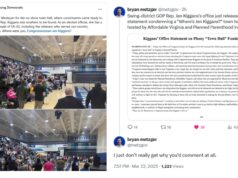 Back in November 2014, I used that year’s VA-10 Congressional race as a case study in looking at whether broadcast TV political ads are a huge waste of money. The short answer: yes, it was basically like flushing down the toilet the money that the candidate (in that case John Foust) had raised over months of (painful, hated) dialing for dollars from big donors. Among other problems:
Back in November 2014, I used that year’s VA-10 Congressional race as a case study in looking at whether broadcast TV political ads are a huge waste of money. The short answer: yes, it was basically like flushing down the toilet the money that the candidate (in that case John Foust) had raised over months of (painful, hated) dialing for dollars from big donors. Among other problems:
- In the end, perhaps 1/7th (14%) or so of market reached by a broadcast TV ad in the DC Metro market reaches the 10th CD. That means 86% of a DC Metro market broadcast TV ad buy is essentially “bleed” — not reaching the targeted audience at all, ergo wasted.
- Within the 10th CD, it’s important to point out that most people reached by a broadcast TV ad in a mid-term election like this will not be likely voters, let alone what you really want: likely AND persuadable voters in the district. The number of those people reached by your (super-expensive) ad? Miniscule. Bang for the buck? Less than miniscule
So…huge waste of money, possibly even NEGATIVE “bang for the buck” (e.g., the more the Foust campaign spent on broadcast TV that year, the worse it did vs. Barbara Comstock). Crazy, eh? But what’s the alternative? As I wrote at the time: theoretically, campaigns COULD shift their resources to field and social/digital media, targeted radio and in-district cable TV, niche publications (e.g., Korean/Spanish/etc. language newspapers and radio stations), print advertising in local papers, stuff like that. That would be much less expensive, but would also be a gazillion times more focused locally, within the district, reducing the absurd “bleed” that’s inherent to broadcast TV advertising.
Anyway, the point of this post isn’t to repeat what I wrote back in November 2014, although clearly I’ve just done a bit of that as an intro. Instead, my point today was simply to point everyone to this article at Harpers by Andrew Cockburn entitled, “Down the Tube: Television, turnout, and the election-industrial complex.” In sum, this article confirms everything I wrote in November 2014. key points:
- Candidates hate raising money, yet: “Ironically, he explained over a beer on K Street, most of the money they raise is wasted, especially on expensive TV campaigns that do nothing to move voters. The principal effect of these labors, he insisted, is to “feed the consultant class.””
- Why? “Such manic spending is driven by a core belief of modern American politics: the votes can be bought if the check is big enough.”
- Also, the “election-industrial” complex of consultants has “desperate candidates” and campaigns convinced this “ineffective” stuff works, even though there’s almost no evidence that it does (Key quote: research finds that “TV, partisan mail, and robocalls had no effect at all.”).
So what to do instead of flushing money down the toilet bowl of broadcast TV advertising? Just as I said in November 2014:
Of all the ways to get people to come out and vote tested by the academics, one emerged as the absolute gold standard. Talking to them face-to-face, the longer the better, turned out to have a dramatic effect. This is known in the trade as the “ground campaign” or “field operation,” conducted by volunteers or paid staff, preferably from the neighborhood they are canvassing. It doesn’t come free: the canvassers, even if they are volunteers, have to be housed, fed, trained, and transported. Yet the effect is infinitely more cost-effective than any traditional media-heavy approach.
Seems like a no brainer, right? So is anyone doing this? Well, yes: “Of the 2016 candidates, Ted Cruz and Bernie Sanders have most successfully embraced the ground-game approach, incorporating sophisticated digital technology to identify likely supporters for canvassing by ground teams.”
But mostly, “traditional campaigns have shown far less interest in engaging directly with voters.” Why not? Now this should piss you off: “Not only does it offer little promise of revenue, it necessarily relies on people more committed and militant than those at the center may deem acceptable.”
Uhhh…alrighty then. So much for Jim Webb’s 2006 “ragtag army” of 12,000+ volunteers, in other words. Not to mention the “draft James Webb” movement and all that. Meh!
By the way, one of the examples cited of a successful “insurgency” campaign that didn’t have the money for broadcast TV is right here in Virginia — the victorious Dave Brat effort against Eric Cantor in 2014. Cantor lost in spite of having “outspent his upstart opponent by a ratio of 41 to 1,” including “$168,000 for steak-house tabs” alone — an amount “almost as much as Brat’s entire campaign.”
Anyway, the bottom line is that Democrats need to change course ASAP, move away from flushing their money down the broadcast TV toilet bowl, investing it instead in field, grassroots and netroots organizing, digital advertising, etc. Or, of course, they can do that classic definition of insanity — repeating the same thing over and over again and expecting to get different results. LOL



 Sign up for the Blue Virginia weekly newsletter
Sign up for the Blue Virginia weekly newsletter
![“Skilled” at Breaking the Law: “This latest attempt to sidestep any regulations or oversight shows [that ‘skill’ game developers] have no interest in acting responsibly or in good faith.”](https://bluevirginia.us/wp-content/uploads/2024/10/krizekskilled-238x178.jpg)
![Kamala Harris for Virginia 2024 Director Jake Rubenstein: “This [Donald Trump] is the man @GlennYoungkin sold his soul to”](https://bluevirginia.us/wp-content/uploads/2024/08/jakesoldsoul-238x178.jpg)






